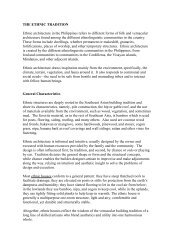THE ETHNIC TRADITION IN PHILIPPINE MUSIC ... - About Philippines
THE ETHNIC TRADITION IN PHILIPPINE MUSIC ... - About Philippines
THE ETHNIC TRADITION IN PHILIPPINE MUSIC ... - About Philippines
Create successful ePaper yourself
Turn your PDF publications into a flip-book with our unique Google optimized e-Paper software.
cultural profile. The numerous ethnic and language groups with orally transmitted<br />
cultural practices may be categorized into six clusters based on history,<br />
geography, topography, kinship of artistic forms, material culture, and social<br />
structures: the Cordillera highland cultures and outlying communities, consisting<br />
of the ethnolinguistic groups of the Apayao or Isneg, Applay, Bago, Bontoc,<br />
Balangao Gaddang, Ibaloy, Ifugao, Ilongot, Kalinga, Kankanay, and Tinguian; the<br />
central west highland, cultures of the Alangan, Batak, Buhid, Hanunuo, Iraya,<br />
Palawan, Tagbanua, Magahat, and Sulod; the Mindanao highland cultures of the<br />
Bagobo, Bilaan, Kalagan, Mandaya, Mansaka, Manobo, Matigsalug, Subanon, and<br />
Tboli; the Aeta communities represented by groups like the Ati, Agta, Abyan,<br />
Dumagat, and Kabihug; the Islamic communities of the Badjao, Ilanun, Jama<br />
Mapun, Maguindanao, Maranao, Sama, Sangil, Tausug, and Yakan; and the rural<br />
Christian communities, including the Ilocano, Ibanag, Pangasinan, Pampango,<br />
Tagalog, Bicol, Cuyunon, Aklanon, Kinaray-a, Ilongo, Cebuano, and Waray.<br />
Many communities in the first four groups were converted to Christianity and<br />
Islam. Although they are integrated into the lowland political and economic<br />
mainstream, some of their ethnic musical traditions are still widely practiced,<br />
especially those that have found areas of accommodation with current religious<br />
and social rubrics. Practices of animist or animistic provenance still exist, although<br />
not as widely as before (Hislop 1971:144-155). Music marks rites of passage and<br />
life-cycle events (birth, initiation, courtship, wedding, death), seasonal events<br />
(planting, harvest), religious-cycle events, and other special occasions<br />
(thanksgiving, war, peace pacts, and anniversaries). Music that accompanied<br />
extinct practices, such as tribal wars and headhunting, have either disappeared or<br />
are performed now but in new contexts.<br />
In community celebrations, group instrumental playing is common, as are dancing,<br />
welcome chants, panegyrics, laments, epics, ballads, allegorical songs, and<br />
extemporized poetry. Solo instrumental playing is done for courting or selfentertainment<br />
while the player watches over the fields, for example, or at intimate,<br />
informal gatherings.<br />
The Islamic cultures are mostly found in the coastal and lowland areas of western<br />
Mindanao. The musical traditions are generally pre-Islamic, integrating folk<br />
culture and court music dating back to the 10th century or earlier. Despite the<br />
fundamental Islamic view that frowns on music, the musical practices of these<br />
communities remain an important element in their social life and one of the chief<br />
sources of their ethnic identities. Moreover, the musical traditions of earlier<br />
Islamic peoples, such as Arabs and Persians, and the modes of rendition of<br />
religious literature, have enriched the musical life of Filipino Muslims.<br />
The distance of rural Christian communities from cities was significant in their<br />
cultural evolution. Western ideas did not come in a constant stream, but were<br />
selected, improvised upon, and modified. Although many activities have been<br />
replaced by Christian-oriented or Christian-derived forms of social practice







